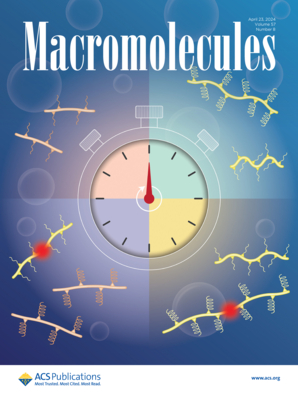扩散控制条件下的 Diels-Alder 可逆网络形成模型
IF 5.2
1区 化学
Q1 POLYMER SCIENCE
引用次数: 0
摘要
在热可逆呋喃-马来酰亚胺 Diels-Alder (DA) 环加成法的基础上,为玻璃化共价适应性聚合物网络建立了一个新的机理模型。为了考虑扩散限制对反应速率的影响,引入了扩散控制的遇对形成机制,并使用 Williams-Landel-Ferry 方程计算了相关的形成和分离速率。利用量热数据和玻璃化转变温度(Tg)随时间和/或温度的变化,对动力学、热力学和扩散参数进行了优化,从而得出了一组可以描述玻璃化条件下特定热固性体系的参数。这些参数也适用于第二种化学性质相似、具有可比 Tg 的可逆网络。最后,获得的参数被用于模拟这些体系的时间-温度-转变(TTT)和连续-加热-转变(CHT)图,包括玻璃化部分。这些结果证明,该模型是一种多功能工具,适用于预测任何时间-温度固化程序的扩散限制效应,有助于准确解释与这些可逆网络有关的分析结果。这对于这些自愈合和可再加工材料的设计和加工具有特别重要的意义。本文章由计算机程序翻译,如有差异,请以英文原文为准。

Modeling of Diels–Alder Reversible Network Formation in Diffusion-Controlled Conditions
A novel mechanistic model is developed for a vitrifying covalent adaptable polymer network based on the thermoreversible furan-maleimide Diels–Alder (DA) cycloaddition. To account for the effect of diffusion limitations on the reaction rates, a diffusion-controlled encounter pair formation mechanism is introduced, with the related rates of formation and separation calculated using the Williams–Landel–Ferry equation. The kinetic, thermodynamic, and diffusion parameters are optimized using calorimetric data and the variation of the glass transition temperature (Tg) with time and/or temperature, leading to a set of parameters that can describe a specific thermosetting system in vitrifying conditions. These parameters are shown to be also valid for a second, chemically similar, reversible network having a comparable Tg. Lastly, the parameters obtained are used to simulate time–temperature-transformation (TTT) and continuous-heating-transformation (CHT) diagrams of these systems, including also the vitrified sections. With these results, this model proves to be a versatile tool suitable for the prediction of the effect of diffusion limitations for any time–temperature cure program, aiding in the accurate interpretation of analytical results related to these reversible networks. This is of particular interest for the design and processing of these self-healing and reprocessable materials.
求助全文
通过发布文献求助,成功后即可免费获取论文全文。
去求助
来源期刊

Macromolecules
工程技术-高分子科学
CiteScore
9.30
自引率
16.40%
发文量
942
审稿时长
2 months
期刊介绍:
Macromolecules publishes original, fundamental, and impactful research on all aspects of polymer science. Topics of interest include synthesis (e.g., controlled polymerizations, polymerization catalysis, post polymerization modification, new monomer structures and polymer architectures, and polymerization mechanisms/kinetics analysis); phase behavior, thermodynamics, dynamic, and ordering/disordering phenomena (e.g., self-assembly, gelation, crystallization, solution/melt/solid-state characteristics); structure and properties (e.g., mechanical and rheological properties, surface/interfacial characteristics, electronic and transport properties); new state of the art characterization (e.g., spectroscopy, scattering, microscopy, rheology), simulation (e.g., Monte Carlo, molecular dynamics, multi-scale/coarse-grained modeling), and theoretical methods. Renewable/sustainable polymers, polymer networks, responsive polymers, electro-, magneto- and opto-active macromolecules, inorganic polymers, charge-transporting polymers (ion-containing, semiconducting, and conducting), nanostructured polymers, and polymer composites are also of interest. Typical papers published in Macromolecules showcase important and innovative concepts, experimental methods/observations, and theoretical/computational approaches that demonstrate a fundamental advance in the understanding of polymers.
 求助内容:
求助内容: 应助结果提醒方式:
应助结果提醒方式:


